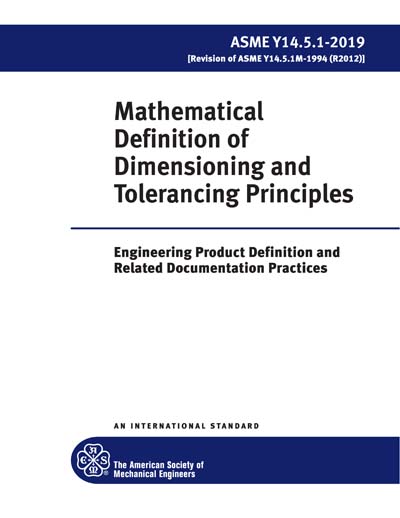Most recent
ASME Y14.5.1-2019
Mathematical Definition of Dimensioning and Tolerancing Principles
This edition is a revision of ASME Y14.5.1M-1994, Mathematical Definition of Dimensioning and Tolerancing Principles, supporting Y14.5-2009. Efforts focused on improving usability with Y14.5 have resulted in harmonization of terms where possible and a realignment of sections consistent with Y14.5-2009. This revision also addresses proposals submitted by the public or members of the Y14 Standards Committee and affiliated subcommittees. See Nonmandatory Appendix A, Principle Changes and Improvements. Work on this revision began in May of 2012 followed by semiannual face-to-face meetings and numerous online collaborative meetings to refine content and disposition comments. Comments on key areas are provided below to add some context to these revisions. This revision includes a new stabilization definition for irregularities on datum features specified at RMB, which provides an alternative to the candidate datum set. SC5 had moved toward the concept of a single-stable solution that minimizes the separation between the datum feature and the true geometric counterpart, and SC5.1 was asked to study the concept and recommend a mathematical definition. A stable Constrained L2 datum definition was selected, which applies as an alternate stabilization definition for Y14.5-2009 and the default stabilization definition for Y14.5-2018. See Nonmandatory Appendix B for results of the study and mathematical definitions. Profile tolerancing was a major focus of development work and the section was completely rewritten. The actual value of profile was changed from the deviation-based two-value definition to a zone-based single-value definition compatible with Y14.5’s tolerance zone definitions. This provides a consistent treatment of unequally disposed and unilateral profile zones, with no change in conformance results. The updated definition allows direct comparison of the actual value with the specified tolerance value, and consistency with actual value definitions for other geometric tolerances. Redevelopment of the profile section also created the requirement to address applications with multiple features and a variety of degree of freedom constraints. This was accomplished by treating profile tolerances as systems with degrees of freedom and constraints, with the Y14.5 tolerance zone and datum reference frame definitions providing the initial conditions. Actual values are defined for a wide variety of profile applications including single features, multifeature groups with and without datum features, simultaneous requirements, and composite profile tolerances. The mathematical definitions for size have not changed; they continue to use the sweeping ball concept to define the tolerance zone volume. Two nonmandatory definitions for local size have been added: one based on opposed points and the other based on inscribed/circumscribed circular elements. Text and figure edits were made to improve readability and clarify content. Changes in sentence structure, organization of content, and method of illustration are not an indication of technical changes. This Standard is available for public review on a continuing basis. This provides an opportunity for additional public review input from industry, academia, regulatory agencies, and the public-at-large. ASME Y14.5.1-2019 was approved by ANSI as an American National Standard on November 7, 2019.
Content Provider
American Society of Mechanical Engineers [asme]






